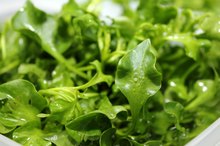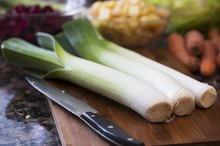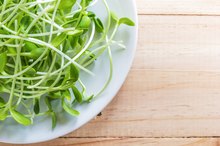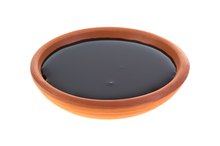What does fact checked mean?
At Healthfully, we strive to deliver objective content that is accurate and up-to-date. Our team periodically reviews articles in order to ensure content quality. The sources cited below consist of evidence from peer-reviewed journals, prominent medical organizations, academic associations, and government data.
The information contained on this site is for informational purposes only, and should not be used as a substitute for the advice of a professional health care provider. Please check with the appropriate physician regarding health questions and concerns. Although we strive to deliver accurate and up-to-date information, no guarantee to that effect is made.
How to Cook Celery in a Microwave
Microwave-steamed celery can serve as a nutritious addition to a main or side dish or be tasty on its own. Although it possesses little in the way of calories, celery does supply a healthy serving of fiber and vitamin A, as well as vitamin C and calcium. Microwave cooking, in contrast to cooking celery on your stovetop, is a way to both prepare this vegetable quickly and preserve its nutritional value.
Separate the celery into individual stalks. If you are serving the celery as a vegetable side dish, use two stalks per serving as a guide to determining how many stalks you need. Follow recipe guidelines if you are microwaving the celery to include it as an ingredient in another dish.
How to Blanch Broccoli
Learn More
Wash the celery by running it under cold water.
Cut 3 to 4 inches from the top of each stalk with a sharp utility knife to remove the leafy section and about 1 inch from the bottom to remove the base.
How to Cook Watercress
Learn More
Chop each stalk into pieces 1 to 2 inches in length for a main dish or according to your recipe guidelines.
Add the celery pieces to a microwave-safe bowl along with about 1/8 cup cooking liquid per cup of celery pieces 1. While water is always appropriate, a cooking liquid such as low-sodium chicken or vegetable broth can be a flavorful substitution.
Cover the bowl to prevent steam from escaping as the celery cooks. If the bowl you are using does not have a microwave-safe cover of its own, use a sheet of wax paper or plastic wrap.
Set the covered bowl in your microwave oven and cook on HIGH for about two to three minutes per cup of celery. Test for doneness with a fork, taking care to protect your hands with oven mitts or hot pads when uncovering the bowl. When fully cooked, the celery should be fork-tender.
Carefully remove the bowl's cover and empty the celery into a colander to strain out the liquid.
Transfer the celery to a serving bowl, sprinkle on some black pepper for seasoning and serve; alternatively, add it as a recipe ingredient.
Related Articles
References
- The Harvard Medical School Family Health Guide: Microwave Cooking and Nutrition
- Dole: Encyclopedia of Fruits & Veggies-Celery
- “The Fannie Farmer Cookbook”; Marion Cunningham; 1996
- Celery, raw. FoodData Central. U.S. Department of Agriculture. Published April 1, 2019.
- Anderson GH, Soeandy CD, Smith CE. White vegetables: Glycemia and satiety. Adv Nutr. 2013;4(3):356S-67S. doi:10.3945/an.112.003509
- Yusni Y, Zufry H, Meutia F, Sucipto KW. The effects of celery leaf (apium graveolens L.) treatment on blood glucose and insulin levels in elderly pre-diabetics. Saudi Med J. 2018;39(2):154-160. doi:10.15537/smj.2018.2.21238
- Eid HM, Nachar A, Thong F, Sweeney G, Haddad PS. The molecular basis of the antidiabetic action of quercetin in cultured skeletal muscle cells and hepatocytes. Phcog Mag 2015;11:74-81 doi: http:10.4103/0973-1296.149708
- Youl, E., Bardy, G., Magous, R., Cros, G., Sejalon, F., Virsolvy, A., Richard, S., Quignard, J., Gross, R., Petit, P., Bataille, D. and Oiry, C., Quercetin potentiates insulin secretion and protects INS‐1 pancreatic β‐cells against oxidative damage via the ERK1/2 pathway. British Journal of Pharmacology, (2010) 161: 799-814. doi:10.1111/j.1476-5381.2010.00910.x
- Tang GY, Meng X, Li Y, Zhao CN, Liu Q, Li HB. Effects of vegetables on cardiovascular diseases and related mechanisms. Nutrients. 2017;9(8). doi:10.3390/nu9080857
- Folate: Fact Sheet for Health Professionals. National Institutes of Health, Office of Dietary Supplements. Updated 2020.
- Vitamin A: Fact Sheets for Health Professionals. National Institutes of Health, Office of Dietary Supplements. Updated 2020.
- Fact or myth: does celery really have negative calories?. Carleton University Dining Services. Updated 2017.
- Allergenic foods and their allergens, with links to informall. University of Nebraska-Lincoln Institute of Agriculture and Natural Resources. Updated 2014.
- Why vitamin K can be dangerous if you take warfarin. Cleveland Clinic. Updated 2019.
- Barone M. Celery juice: Are the benefits real?. UC Davis Health. Updated 2019.
- Combs M H, Ernst M. Celery and celeriac. University of Kentucky College of Agriculture, Food and Environment Cooperative Extension. Updated 2019.
- Celery. University of Nebraska Lincoln Extension.
Writer Bio
Based in Green Bay, Wisc., Jackie Lohrey has been writing professionally since 2009. In addition to writing web content and training manuals for small business clients and nonprofit organizations, including ERA Realtors and the Bay Area Humane Society, Lohrey also works as a finance data analyst for a global business outsourcing company.









